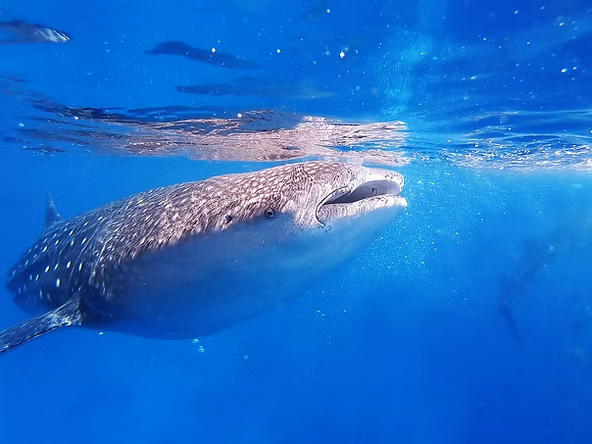Whale Sharks: Giants of the Ocean
Whale sharks hold the title of the largest fish in the world. Despite their name, they are not whales but rather sharks. However, their massive size and filter-feeding habits make them more similar to whales than to typical predatory sharks. These gentle giants are awe-inspiring yet vulnerable to human and environmental pressures.
Size and Appearance
Whale sharks can reach lengths of up to 40 feet (12 meters), though most average between 18 and 33 feet (5.5 to 10 meters). They can weigh up to 20.6 tons (18.7 metric tonnes), about the size of a school bus. In comparison, great white sharks, though famous, are much smaller, growing only to about 15 to 20 feet and weighing over 5,000 pounds. Unlike great whites, whale sharks are non-predatory.
Their bodies are distinctive, with flattened heads and blunt snouts. They have short barbels near their nostrils, gray to brown backs decorated with white spots and pale stripes, and white bellies. Each individual whale shark has a unique spot pattern, much like human fingerprints. Their mouths can stretch 5 feet wide and contain more than 300 small teeth, though these are not used for feeding.
Habitat and Distribution
Whale sharks prefer warm, tropical waters but can occasionally be seen in cooler regions, including near New York’s coast. Most of the population — around 75 percent — lives in the Indian and Pacific Oceans, with the rest in the Atlantic. These wide-ranging habitats make whale sharks a truly global species.
Behavior and Habits
Whale sharks are largely solitary, though they do not avoid feeding alongside others. The Red Sea, for example, is a gathering place for juveniles that feed together. Scientists still have much to learn about their social behaviors, as they remain less studied compared to other marine animals.
Diet and Feeding
Unlike predatory sharks, whale sharks are filter feeders. They swim with their mouths open, drawing in water, filtering out plankton and small marine life, and expelling the rest. Their diet includes:
- Plankton
- Shrimp and small fish like sardines, anchovies, and mackerel
- Squid, tuna, and albacore
- Algae and marine plant material
- Fish eggs, often consumed after patiently waiting for spawning events
Reproduction and Lifespan
Whale shark reproduction is unique. Females produce eggs that hatch inside their bodies, giving birth to as many as 300 live young. However, few survive to adulthood. Offspring mature only around the age of 25, reflecting their long developmental period. Whale sharks can live between 100 and 150 years, making them one of the longest-living fish.
Classification
Whale sharks belong to the species Rhincodon typus in the family Rhincodontidae. They are part of the class Chondrichthyes, which includes all cartilaginous fishes like sharks and rays. This places them firmly within the shark lineage, despite their similarities to whales.
Conservation Status
The conservation outlook for whale sharks is concerning. According to the International Union for Conservation of Nature (IUCN), the Indo-Pacific population has declined by 63 percent over the past 75 years, while the Atlantic population has dropped by more than 30 percent. With numbers still decreasing, whale sharks are officially classified as endangered. Protecting them requires global efforts to safeguard their habitats and reduce threats such as fishing and ship strikes.

